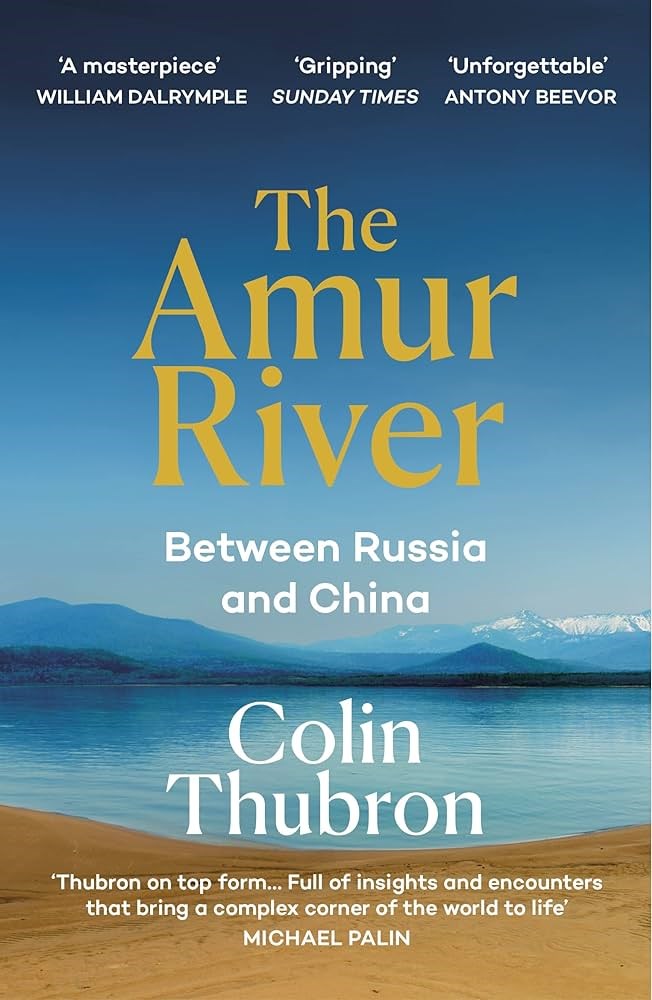The Amur River Between Russia and China
Colin Thubron.
Chatto & Windus, 291 pages.
Colin Thubron writes fiction but is better known (to me, at least) as a travel writer.
His latest book is about a river which divides: “I stare out on a leaden sea, remembering others of the earth’s great rivers that carry no such tensions: the Nile, the Yangtse, the Ganges, the Amazon, the Indus. However threatened, they flow like lifeblood through their nations’ heart. Only the Amur divides.”
The Amur River is the eighth or tenth longest river in the world, depending on who one reads. It flows through Siberia for about 4500 km, and for just over 1600 km it forms a densely fortified border between Russia and China.
Thubron travelled 3000 km along the banks of this waterway, describing his experiences, the scenery and climate but also, and this forms the backbone of the book, its history and his interactions with people he meets along the way.
The journey does not start well. He breaks three ribs, soon followed by an ankle bone, yet continues onward without medical help in spite of what must have been tremendous pain, made worse by the difficult terrain. Being eighty years old could not have helped, and he wryly describes his two guides’ barely concealed concern.
Although the USSR had disintegrated, this is still Putin’s Russia and the police are ever vigilant. He is detained and questioned more than once, raising their suspicions even more by telling officials about aspects of their region’s history that they themselves were unaware of. Where did you learn this, he was asked, why do you know more that we do?
Russian antipathy towards the Chinese across the river is almost palpable, in spite of officially friendly diplomatic and other relations between the two countries. The Russians along the river are clearly patriotic but seemed resigned, almost apathetically so, to the fact that they are sliding backward economically, while the Chinese cities on the opposite banks are in-your-face prosperous, albeit in in a rather gaudy sort of way.
Visiting the Chinese territory, he establishes an ephemeral friendship with a guide who makes it clear that the hatred is mutual: “Frankly, I hate the Russians… we hate them because they took our land.” He also discovers that the Chinese police are just as distrustful of foreigners as their Russian counterparts.
Given the interesting history of Russo-Chinese interaction in Tsarist times, which Thubron describes in some detail, it becomes clear that the Chinese have grounds for complaint. One can foresee a border dispute in the future.
The river, like so many others, is subject to increasing pollution: “I imagine this pollution-stained advance through Russians’ eyes. Their industrial poverty has kept the Amur purer, while the resurgence of China is defiling it.”
During the nineteenth and early twentieth centuries the Tsarist government regarded this part of the country as an economic bonanza, expecting it to develop into one of the world’s great trading and mining centres. Many towns and cities were established or expanded along the course of the river, such as Svobodny, Blagoveshchensk, Khabarovsk and Bogorodskoye, beautiful names ready to jump off the page and onto the tongue and which inevitably made me think of saltimbocca. (Not a Russian word, I know, I know…)
Thubron describes the initial optimism and expansion, the resultant disaster and decay, made worse by autocracy and communism, as the realization dawned that this was no El Dorado. What makes this even sadder is that the national identities of many local tribes or small nations along the course of the river were successfully obliterated by the Soviet regime in an attempt to mould Homo Sovieticus, a policy which inevitably failed, leaving nothing to fill the cultural void.
Thubron’s journey is thus a melancholy tale of sadness and loss, strikingly portrayed when he is approached by two Russian girls: “We had a bet you were not Russian.
Why not?
Their laughter peals in chorus. Because you look happy!”
I have read two other travel books by this author (Among the Russians and In Siberia) and anyone not impressed by the lyrical nature and sheer beauty of Thubron’s prose must have the literary equivalent of tone deafness.
I also came to realize that he is much more than “just” a travel writer.
The depth of insight and breadth of knowledge, the sheer humanity of his descriptions, the aforesaid beauty of his prose raise his books far above the level of the usual Cape Town to Cairo or Around the World on a Horse with No Name travelogues. Every one of his books recounting a journey through any part of the world is a work of art which should be remembered and is worthy of a revisit – I can certainly see myself rereading this volume in a few years’ time.
The views and opinions expressed in this article are those of the author, and do not necessarily reflect the position of this publication.




